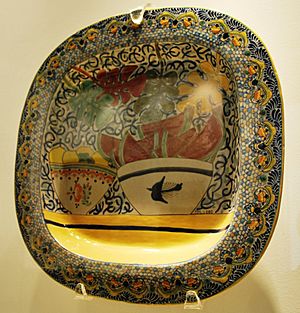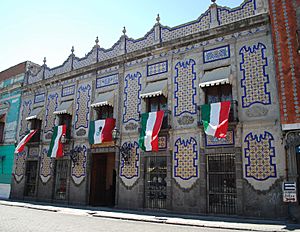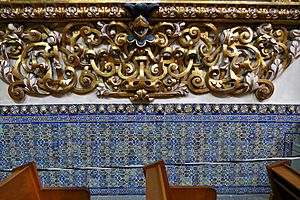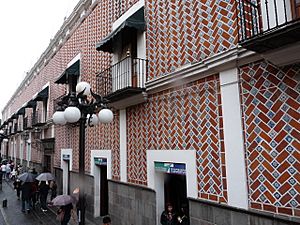Artisanal Talavera of Puebla and Tlaxcala facts for kids
Talavera pottery is a special type of Mexican pottery. It comes from the states of Puebla and Tlaxcala. This craft has a long history, inspired by similar pottery from Talavera de la Reina in Spain. In 2019, both the Mexican and Spanish Talavera traditions were recognized by UNESCO. They were added to a list of important cultural heritage around the world.
Mexican Talavera is a kind of majolica pottery. This means it's made from earthenware clay and covered with a shiny white glaze. It's made in towns like San Pablo del Monte in Tlaxcala, and Puebla, Atlixco, Cholula, and Tecali in Puebla. These places have the right kind of natural clay for this pottery. The tradition started way back in the 1500s.
Many early Talavera pieces were decorated only in blue. But over time, artists started using other colors too. These included yellow, black, green, orange, and even a soft purple called mauve. Spanish people brought majolica pottery to Mexico during the early colonial period. Making this pottery became very popular in Puebla. This was because of the good clay and the high demand for tiles. New churches and monasteries needed lots of tiles for decoration.
By the mid-1600s, the pottery industry grew a lot. Rules and groups called guilds were set up. These helped make the pottery even better. This time, from 1650 to 1750, is known as the "golden age" of Talavera. The pottery made in Puebla is officially called Talavera Poblana. This helps tell it apart from the Spanish Talavera. It's a mix of Italian, Spanish, and local Mexican pottery styles.
The craft faced challenges after the Mexican War of Independence in the early 1800s. Many workshops closed down. But in the early 1900s, artists and collectors helped bring it back. Today, you can find large collections of Talavera pottery in Puebla, Mexico City, and New York City. More recently, in the late 1900s, people worked to protect and promote Talavera. New designs were created, and a law called Denominación de Origen de la Talavera was passed. This law helps make sure that only real Talavera, made with the old methods, can be called Talavera.
Contents
What is Talavera Pottery?
Real Talavera pottery comes mainly from Talavera de la Reina in Spain. In Mexico, it comes from San Pablo del Monte (Tlaxcala) and the cities of Puebla, Atlixco, Cholula, and Tecali. These places have the right clays and a long history of making this craft.
Every piece of Talavera is shaped by hand on a potter's wheel. The glazes used contain tin and lead, just like they did hundreds of years ago. This glaze should have tiny cracks, be a bit porous, and look milky-white, not pure white. Only six colors are allowed for decoration: blue, yellow, black, green, orange, and mauve. These colors must come from natural pigments. The painted designs look a little blurry because they blend into the glaze. The bottom of the piece, which touches the table, is not glazed. This shows the natural clay underneath.
Each authentic Talavera piece must have special marks on the bottom. These include the maker's logo, the artist's initials, and the location in Puebla where it was made.
The way Talavera pieces are designed follows strict traditions. The paint on the surface is slightly raised. In the past, only a deep blue color called cobalt was used. This was the most expensive color, so using it showed the piece was high quality. Only natural clays are used, not chemically treated ones. The whole process of making a piece takes about three to four months. It's a tricky process because a piece can break at any time. This makes Talavera pottery more expensive than other types.
Because it's so special, Talavera makers face challenges from fake products. These often come from places like China or other parts of Mexico, especially Guanajuato. Guanajuato tried to get permission to call their pottery "Talavera" too. But since 1997, only pottery from the special areas in Puebla can use the name. Other glazed ceramics from Mexico are called Maiolica.
Today, only pieces made in the special areas and by certified workshops can be called "Talavera." A group called the Consejo Regulador de la Talavera gives out these certifications. So far, only nine workshops are certified. These include Uriarte Talavera, Talavera La Reyna, and Talavera Armando. Each certified workshop is checked twice a year to make sure they follow the traditional methods. The pottery pieces also go through sixteen lab tests. A test by the University of Puebla checks that the glaze is safe for food. It must have very low levels of lead and cadmium. Only pieces from workshops that meet these high standards get the potter's signature, the workshop's logo, and a special hologram to prove they are real.
How Talavera is Made
Making Talavera pottery is a detailed process. It has stayed mostly the same since it first came to Mexico.
1. Mixing the Clay: First, black sand from Amozoc is mixed with white sand from Tecali. 2. Washing and Filtering: This mixture is washed and filtered. Only the finest clay particles are kept. This can reduce the amount of clay by half! 3. Shaping: Next, the clay is shaped by hand on a potter's wheel. 4. Drying: The shaped piece is left to dry for several days. 5. First Firing: Then, it goes into a kiln for the first firing at 850 degrees Celsius (about 1562 degrees Fahrenheit). After this, the piece is checked for any cracks. 6. Glazing: A milky-white glaze is applied. This creates the background for the design. 7. Painting: The design is then carefully painted by hand. 8. Second Firing: Finally, the piece is fired a second time to harden the glaze.
This whole process usually takes about three months for most pieces. Some larger or more complex pieces can take up to six months. Because the process is so complex and risky, artisans in colonial times even said special prayers, especially during the firing.
Some workshops in Puebla, like Uriarte, offer tours. You can see how the pottery is made. Uriarte is the oldest certified workshop still running. It started in 1824 and focuses on traditional designs. Another certified workshop, Talavera de la Reina, is known for adding new, modern designs. They invited Mexican artists in the 1990s to create fresh looks for the ceramics.
What Talavera is Used For
Talavera ceramic is used for many things. It makes useful items like plates, bowls, jars, flowerpots, and sinks. It's also used for religious items and decorative figures. A very important use for Talavera is for tiles. These tiles are called azulejos. They decorate both the inside and outside of buildings in Mexico, especially in Puebla.
Puebla kitchens often feature Talavera pottery. You can see it on the walls, counters, dishes, and food containers. It creates a very unique kitchen style. In old monastery kitchens, many designs even included the symbol of the religious group. Many buildings in Puebla's historic center are covered with these beautiful tiles. These azulejos are found on fountains, patios, and the fronts of homes, churches, and other buildings. They are a key part of Puebla's Baroque architecture.
Having a house covered in azulejos showed how wealthy a family or church was. There was even a saying: "to never be able to build a house with tiles." This meant someone wouldn't achieve much in life. This display of wealth wasn't just in Puebla. In Mexico City, the church of the Convent of La Encarnacion and the church of the Virgin of Valvanera have domes covered in Talavera.
The most famous example of Talavera in Mexico City is the Casa de los Azulejos, or House of Tiles. This is an 18th-century palace. What makes it special is that three sides of its outside are completely covered in expensive blue-and-white tiles. This was amazing when the tiles were first put on!
History of Talavera Pottery
The art of Islamic pottery came to Spain with the Moors around the late 1100s. This style then influenced pottery across Spain and Europe. It became known as majolica. Spanish artists from Talavera de la Reina in Spain learned and added to this art. Italian styles were also mixed in as the craft grew in Spain. Guilds were formed to make sure the quality was high.
At the same time, before the Spanish arrived, Mexican cultures had their own pottery traditions. But they didn't use a potter's wheel or glazes. There are different ideas about how majolica pottery came to Mexico. The most common idea is that monks brought it. They either asked Spanish artists to come or knew how to make the ceramics themselves. These monks wanted tiles and other items for their new monasteries. To meet this need, Spanish artists or the monks taught local Mexican artists how to make glazed pottery. Many potters also came to Mexico from Seville and Talavera de la Reina in Spain very early in the colonial period. A famous potter named Diego Gaytán, from Talavera, Spain, had a big impact on pottery after he arrived in Puebla.
When the city of Puebla was founded in 1531, many churches and monasteries were being built. They needed lots of tiles. This, plus the good quality clay in the area, helped the ceramic industry grow. Soon, both local people and Spanish artists were making pottery. This led to a mix of styles, especially in the decorations. The new pottery became known as Talavera Poblana to tell it apart from Spanish Talavera. By 1550, Puebla was making high-quality Talavera. By 1580, it was the main center for Talavera production in Mexico.
From 1580 to the mid-1600s, more and more potters and workshops appeared. Each had their own designs. The colonial government decided to set rules for the industry. In 1653, the first rules were passed. These rules said who could be a craftsman, what quality levels products had, and how they should be decorated. This helped make the pottery more standard and improved its quality. For example, only the best pieces could use blue cobalt. Craftsmen had to mark their pieces to prevent fakes. There were also quality levels: fine, semi-fine, and daily use. Master potters had yearly checks.
The time between 1650 and 1750 is called the Golden Age of Talavera. Puebla became the most important pottery center in New Spain (colonial Mexico). Talavera pieces were sent all over the territory. They even went to places like Guatemala, Cuba, and Venezuela. During this time, blue became the most popular color for Talavera. This was partly because of the influence of Chinese ceramics from the Ming dynasty. These Chinese pieces came to Mexico on ships called Manila galleons. In the 1700s, Italian influences brought in the use of other colors.
During the Mexican War of Independence, the potters' guilds and old rules were ended. This meant anyone could make the ceramic any way they wanted, which led to lower quality. The war also stopped trade between Spanish colonies. Cheaper English porcelain started to be imported. The Talavera market crashed. Before the war, there were forty-six workshops. After the war, only seven were left.
In 1897, a man from Spain named Enrique Luis Ventosa came to Puebla. He loved the history of Talavera. He studied the old ways of making it and mixed them with his knowledge of modern Spanish art. He wrote articles and poems about the tradition. In 1922, he met Ysauro Uriarte Martinez, a young potter who had taken over his grandfather's workshop. They worked together to create new designs. They added influences from ancient Mexican art and Art Nouveau to the existing Islamic, Chinese, Spanish, and Italian styles. They also worked to bring back the high quality of Talavera. Their timing was good because the Mexican Revolution had just ended, and the country was rebuilding.
However, by the 1980s, the number of workshops had dropped again. Only four remained. Talavera faced challenges from pottery made in other Mexican states, cheap imports, and a lack of new designs. In the early 1990s, the Talavera de la Reina workshop started to revive the craft. They invited famous artists to work with their artisans. These artists created new pieces and designs. They didn't change how the pottery was made, but they added human figures, animals, and new flower patterns to the designs.
Since then, the craft has seen a comeback. In the 2000s, seventeen workshops were making Talavera using the old traditions. Eight of them were working to get certified. These workshops employed about 250 people. They exported their pottery to the United States, Canada, South America, and Europe.
Even though the Spanish brought this pottery style, the name Talavera is used much more in Mexico than in Talavera de la Reina, Spain. In 1997, the Denominación de Origin de la Talavera was created. This law controls what pieces can officially be called Talavera. It sets rules for where it's made, the clay used, and the making methods. These certified pieces now have holograms. The law was passed to protect the tradition because the remaining Talavera workshops had kept the high quality and old crafting process from colonial times.
Still, the tradition faces difficulties. Angelica Moreno, who owns Talavera de la Reina, worries that fewer young people are interested in learning the craft. An artisan earns about 700 to 1,800 pesos a week, which might not be enough to live on.
Talavera in Museums
In the early 1900s, people became interested in collecting Talavera. In 1904, an American named Emily Johnston de Forrest found Talavera on a trip to Mexico. She started collecting it and asked experts for help. Her collection later became the basis for what is shown at the Metropolitan Museum of Art in New York. Her excitement inspired Edwin Atlee Barber, a curator at the Philadelphia Museum of Art. He also spent time in Mexico and added Talavera to his museum's collection. He studied the different styles and how to spot the best pieces. He published a guide in 1908 that is still important today.
At the same time, important museum collections were being built in Mexico. One of the first was Francisco Perez Salazer's collection in Mexico City. Later, in the 1920s, Franz Mayer, a stockbroker from Germany, started his collection. In Puebla, people thought he was a bit strange for buying all the "old stuff" from locals. In 1986, the Franz Mayer Museum opened in Mexico City. It has the largest collection of Talavera Poblana in the world. It includes 726 pieces from the 1600s to the 1800s, plus some 1900s pieces by Enrique Luis Ventosa. In Puebla, José Luis Bello y González and his son José Mariano Bello y Acedo asked Ventosa for advice on starting their collection. They gathered the biggest and most important collection in the city. It is now in the José Luis Bello y González Museum (Bello Museum).
More recently, the Museo de la Talavera (Talavera Museum) opened in Puebla. It started with 400 pieces. The museum tells the story of Talavera's beginnings, history, and different styles. It shows both simple and very complex pieces from different time periods.
Some temporary and traveling exhibits have been created from these museum collections. One exhibit was called "El Aguila en la Historia de Mexico" (The Eagle in the History of Mexico). This exhibit had forty-two pieces. It was sponsored by the Senate of Mexico to show how the eagle symbol has been used in Mexico's history. This exhibit celebrated Mexico's 200th anniversary of independence in 2010. These ceramics were chosen because they combine art and usefulness. The eagles shown included Mexico's national symbol, as well as those used by important figures like José María Morelos y Pavón and Porfirio Díaz. Eagles used by institutions like the Royal and Pontifical University of Mexico were also featured.
Another exhibit in Mexico focused on maps made with Talavera tiles. Most tiles in colonial times had flowers or landscapes. But many were painted to create murals with maps. The maps that still exist show how cities grew during the colonial period. Eight of the best 16th-century Talavera tile maps were shown at the El Carmen Museum. The exhibit was called "Cartografia: Una Vision en Talavera del Mexico Colonial" (Cartography: A Talavera Vision of Colonial Mexico). These were copies of the originals, made by the Talavera de la Luz workshop in Puebla. The maps showed the growth of Mexico City, as well as areas like Acapulco, Puebla, and Tesuco during that time.
Exhibits have also been held outside of Mexico. The Museum of the Americas in Spain had an exhibit called "Talaveras de Puebla, Cerámica colonial Mexicana. Siglos XVII a XXI" (Talavera Pottery of Puebla, Mexican colonial ceramics, 17th to 21st centuries). This was a temporary exhibit of 49 pieces. It also included pieces from Spain and China for comparison. The pieces were borrowed from the Franz Mayer Museum and the Bello Museum.
See also
 In Spanish: Talavera mexicana para niños
In Spanish: Talavera mexicana para niños
- Mexican handcrafts and folk art
- Mexican pottery and ceramics
- Azulejo
- Cesar Torres Ramírez
- Cayetano Corona Gaspariano
- Uriarte Talavera
- Talavera de la Reina pottery










